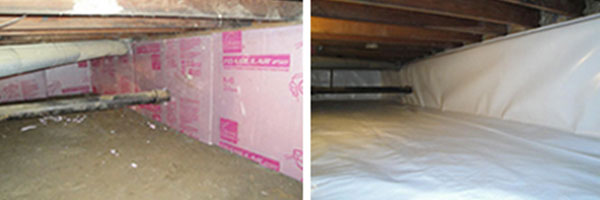Crawl space encapsulation & dehumidifier
The crawlspace! No one is thinking about their crawlspace, that damp, spider infested, dark and scary place underneath your home that no one wants to enter unless they absolutely have to. For most home homeowners, the crawlspace is a forgotten part of their home. Usually there is a small wooden access door to the crawlspace that most homeowners haven’t opened for years unless they needed to discard or hide some unsightly item in their yard.
For many, many years the building industry didn’t spend much time thinking about the crawlspace either. The standard practice was to scrape the ground inside the foundation, pour the footer, install the foundation wall on the footer and install a few vents and a small access door in the foundation. After that, the builders also forgot about the crawlspace.
We are now learning that the crawlspace should not be forgotten. The thinking and science behind crawlspaces is rapidly changing. The article below from the Building Science Corporation explains the importance of crawlspace encapsulation and waterproofing and the effects an untreated crawlspace can have on health and home.
Building Science Corporation – June 18, 2015
Crawlspaces should be designed and constructed as mini-basements. Crawlspaces should not be vented to the exterior (see FAQ on Crawlspace Venting). They should have their floors uninsulated, the ground vapor sealed, their walls insulated and air sealed, and their air conditioned with indoor air. Traditional vented crawlspaces are often damp, moldy and inhabited with pests. They have almost universally been found to be well connected to indoor air through many small unintentional air leaks in the floors, partitions, and ducts. Therefore, to ensure both durability and indoor air quality (and save energy), a crawlspace must be kept dry, conditioned to control temperature and humidity, and sealed tight to be pest free. This is particularly important for crawlspaces that contain mechanical equipment—a situation that is practically guaranteed in buildings that have a crawlspace. Mechanical systems should not be installed outside of a home in unconditioned space unless there is no practical alternative. Crawlspaces should have a continuous sealed groundcover of vapor diffusion resistant materials, such as taped polyethylene or, preferably, a thin poured concrete slab over polyethylene with perimeter and control joints sealed. When the crawlspace ground level is below the ground level of the surrounding grade they should have perimeter drainage just like a basement. There must be good drainage away from crawlspaces (refer to Information Sheet 101: “Groundwater Control”). Crawlspace design and construction should also provide drainage for potential plumbing leaks or flooding incidents by sloping the ground level to a drain. (Read full article here)

If your home has a traditional crawlspace with a dirt floor and open vents, it is time to think about your crawlspace in a new way. Your B-Dry® Systems of Louisville consultant understands the importance of eliminating moisture from your crawlspace and can recommend the most effective solution for removing it.
Ready to eliminate the moisture in your crawlspace?
We offer many, cost effective solutions.
Call us anytime (502) 968-4444
B-Dry® Systems of Louisville offers full crawlspace encapsulation using the highest quality vapor barriers and typically installed within one day. We can provide a number of water removal solutions if your crawlspace is experiencing excessive water during rainfall. If you have open vents in your foundation, we can seal them up and install energy saving insulation on your foundation walls. Our consultants will inspect your crawlspace and offer customized solutions to solve any problems that may be found.

